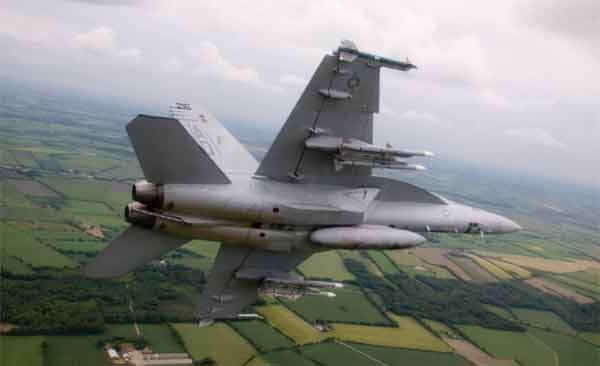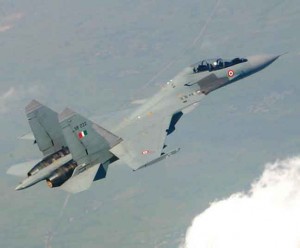Boeing F/A-18E/F Super Hornet
The Boeing F/A-18E/F Super Hornet is a twin-engine multirole fighter. The variant on offer to India, the F/A-18IN, was the same as the one operated by the US Navy and being built for the Royal Australian Air Force (RAAF). Raytheon APG-79 AESA radar has been offered on the aircraft. Boeing has proposed the joint manufacture of the jets with Indian partners. It also planned to offset the cost by setting up a $100 million maintenance and training hub in Nagpur. This would be the first time the Super Hornet has been offered for production in a foreign country.
Boeing has proposed the joint manufacture of the jets with Indian partners…
Boeing and Tata Industries agreed to form a joint-venture company. The new entity would supply components for Boeing military aircraft worldwide, including for the Super Hornet. Boeing has long-term partnership agreements with HAL, Tata Industries, and Larsen & Toubro. The F-18 first flew in 1978 and has been operated by the US Marines and US Navy, Royal Australian and Spanish Air Forces. The F-18s are also flying in Canada, Finland, Kuwait, Malaysia and Switzerland. The US Navy’s Blue Angels Flight Demonstration Squadron has been flying the F/A-18 Hornet since 1986. F/A-18E/F Super Hornet is the latest variant. The initial unit cost was suggested as $60 million.
The Hornet has seen combat since 1986 in Libya and then in the Gulf and Iraq wars of 1991 and 2003. The F/A-18E/F Super Hornet is not just an upgrade of basic aircraft, but rather a newer, larger airframe. The aircraft will be replaced by F-35C Lightening-II in the US Navy. While the earlier variants had the GE 404 engine (same as LCA Mk I), the Super Hornet has the GE F414 engines which will come on the LCA Mk II. Boeing was also willing to support taking Indian manufacturing to global standards. Boeing has already bagged the Chinook and Apache helicopter contracts and has in the recent past, supplied to India the C-17 Globemaster III and the Poseidon P-8I maritime aircraft. Combined Hornet requirements for the IAF and the Indian Navy could be around 200 and may justify production. The Indian Navy is also in talks with USA for the EMALS CATOBAR for its indigenous aircraft carrier.
About a third of India’s 650 combat planes are more than 40 years old and set to retire in the next decade…
Balancing the Baskets
About a third of India’s 650 combat planes are more than 40 years old and set to retire in the next decade. India’s fighter aircraft basket is gradually moving away from the tight Russian ‘Bear Hug’. On one end we have large numbers of Russian SU-30 MKI forming close to 12 Squadrons. Three squadrons of upgraded MiG-29s will fly for over a decade. The Indo-Russian FGFA has already been committed. In view of reduced interest of Russian Air Force who prefers to acquire more SU-35s, funding and risk will shift heavily on Indian shoulders. The Indigenous LCA squadrons are unfortunately increasing very slowly due production hold-ups. Just 36 French Rafale fighters is also a very unrealistic operational number. There are only four squadrons of Anglo-French Jaguars. The IAF continues to be heavily Russia-centric.
Decision Matrix India
Prime Minister Modi has indicated plans to spend $150 billion to create jobs in defence production. The F-16 and the Gripen are both single-engine aircraft and the F-18 is twin-engine. All aircraft have already been technically evaluated during MMRCA trials. In the absence of a formal Request for Proposal (RfP), numbers required and technical requirements are still not clear. Will the government follow the standard time-consuming Defence Procurement Procedure or fast track through government-to-government contract, still has to evolve.
The IAF will have to take a call on whether it really requires another twin-engine aircraft after large numbers of SU-30 MKI and now a few Rafale jets. Single engine aircraft will be cheaper and will be easy to make good IAF’s depleting numbers. Cost, extent of technology transfer and support in setting up production facilities will be key factors for selection. India will also have to take a call on the liabilities for servicing older customers that will shift along with exclusive production line. All these aircraft have gone through major airframe, engine and avionics upgrades over the years. Effectively the aircraft can be called of current vintage.
The IAF will have to take a call on whether it really requires another twin-engine aircraft after large numbers of SU-30 MKI and now a few Rafale jets…
Saab has already offered the latest Gallium Nitrate AESA technology without any restrictions. USA has still to offer full AESA technology. Having failed in developing the Kaveri engine, India desperately needs aircraft engine technology. Gripen NG has high reliance on US-supplied hardware, including electronics, weaponry and the GE F414 engine, as a factor that may hamper its ability to be exported. There are little over 200 Gripen in service with various military users. This would mean a very small market for India. While on the one side India will always be able to deal from a position of strength with Sweden, on the other side Sweden has little leverage to support India in any international forum.
While Americans have greater power to arm-twist India or put restrictions, but they critically need India in their Asia-Pacific pivot strategy. India can take advantage of this. A large number of fighter aircraft around the world are using American engines. The GE-414 would bring commonality with the LCA Mk II. India has already indicated this to USA under the bilateral Defense Technology and Trade Initiative (DTTI). Internationally, 300 aircraft is a cost-effective production line to set-up. Whichever aircraft India chooses must carry on for at least 40 years without technological obsolescence. But we may still be dependent on a US firm for the engine. India is closing up with USA militarily. Logistics Exchange Memorandum of Agreement (LEMOA) has just been signed. More agreements will follow. India needs a big power as a deterrent for possible two-front war threat by China and Pakistan combine.
Advantage F-16
Since this would be one of the biggest projects under the ‘Make in India’ programme, all decisions have to carefully weighed and balanced. Given the relatively small market for the Gripen, despite the recently-announced deal with Brazil, it would be doubtful that a similar deal with India would be profitable. Presently, 26 countries operate the F-16. Many will continue to do so for next 15 years or more. The F-16 is truly a global system with a globalised market and supply chain. Most importantly, the F-16 is the backbone of the fighter force structure of these countries. If the entire production were to shift to India, the price of the platform would decrease due low skilled labour cost. Countries that would like to purchase a fourth-generation aircraft but, which currently cannot afford to do so, may enter the market if prices decline. This deal will provide India enormous opportunities to become the sole supplier of a truly international platform with a proven and viable market.
Among these various options, only the F-16 will provide India with a serious leap forward in developing a robust military-industry base…
Among these various options, only the F-16 will provide India with a serious leap forward in developing a robust military-industry base. This will help Indian defence industry to find firm roots and become a supply hub like the automobile industry did. None of these aircraft though have advanced airframe features of modern stealth. The Block-70 ‘Viper’ configuration offered to India is still being evolved by Lockheed Martin with current orders for just 15 aircraft. Lockheed has proposed to build the latest variant of the fighter, the F-16 Block 70 in India. Block 70 fighters would be the finest combat planes in the region. If the two governments reach an agreement by 2017, Lockheed Martin could roll out the first made in India jet in 2019-2020. Lockheed has already supplied six C130J Super Hercules and is set to deliver another six in 2017. USA is also willing support India’s Vikrant class indigenous aircraft carrier development with latest EMALS Catapult-Assisted Take-Off system.
US relations with Pakistan have worsened in recent years. In May 2016, the US Congress, refused to give subsidies for Pakistan to buy new F-16s and withheld aid to Pakistan over its failure to take action against terrorists carrying out attacks on American troops in Afghanistan. With respect to denial, India should insist on having an explicit position to deny Pakistan further purchases under such an arrangement. India will also need assurance of free hand for future sales. India should negotiate a process by which Indian concerns are deemed as valuable as those of the US. India should also use the deal to put greater pressure on Pakistan on India’s security concerns. India would have to form partnerships with manufacturers to permit the production of key components in India. These are reasonable requests which would both make the deal more politically palatable to India and also address some of India’s core concerns about security and its core interests in being an equal partner with the US.
Through this matrix, by 2030 India could essentially have the indigenous LCA and AMCA, Indo-Russian FGFA and Su-30 MKI licence produced in India and American F-16 Viper local production with full technology transfer. French Rafale with ToT and private sector production. We will have state-of-the art aerial armaments from the three countries. Some can be cross integrated. Our aircraft sourcing will be from three foreign baskets. Types of aircraft will stabilise at six types of fighters.






